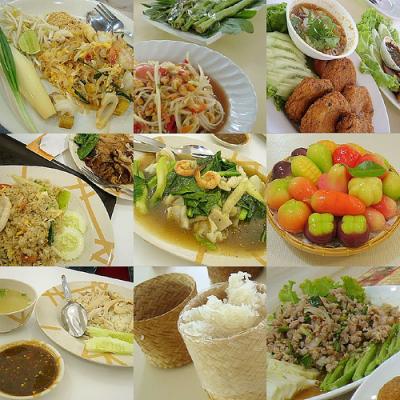
Indian and Chinese meals have gained vast acceptance as recent generations have grown up with their presence. Other spicy meals that have long been widespread in the USA, comparable to Mexican and Thai, have taken longer to become established in the UK. Mexican delicacies remains to be something of a novelty, however Thai food has enjoyed a veritable explosion of popularity within the final decade.
It’s, maybe, the common presence of rice that misleads the uninitiated Brit into assuming that every one of the South East Asian food is way the same. This false impression, though typical of the British indifference to, and ignorance of, unique cultures, couldn’t be further from the truth. The 4 regional kinds that comprise Thai cuisine include a range of unique and spectacular dishes. While the influence of Thailand’s Asian neighbours, particularly China, is present in some recipes, the richly structured native Thai delicacies advanced from a fusion of many influences. Trade routes brought input from Europe as well as different pats of Asia.
Thai cuisine has components in common with both Indian and Chinese meals, but offers advantages over both. The fragrant flavours are more outstanding and assorted than in Chinese language food, and the vast majority of dishes are lighter and less fatty than Indian foods.
Rice, vegetables, fish and recent herbs and spices are important elements. Some widespread Thai components, such as turmeric, which has anti-oxidant and anti inflammatory properties, are sometimes included in lists of so-called “super foods”. When one additionally considers the comparatively small quantity of crimson meat used in Thai recipes, it’s not surprising that it’s regarded as one of many healthiest cuisines in the world.
But, well being issues aside, the most effective reason for the timid British diner to strive Thai food is its spectacular range of flavours. To get the total benefit of the expertise, it’s a good suggestion to partake of a meal served in the conventional manner. The company of two or three folks is a lot nicer than eating alone, so a Thai meal ought to be a communal occasion. On the whole, the more folks present, the more dishes will be ordered, and the more different things could also be tried. As a rough guide, it is perhaps expected that two people would order three dishes in addition to their rice. Three diners may order 4, or possibly five, dishes.
When the meals arrives, every dinner guest will obtain an individual plate of rice, which forms the base upon which she could construct a meal in response to taste from the dishes which were ordered. Each will choose whatever she fancies from the shared dishes and add it to her plate of rice. Whereas eating the meal, soup may be loved as an accompaniment and doesn’t need to be taken as a separate course. This typically surprises first-time diners.
Thai meals is often eaten with a fork and spoon; one thing which enormously reassures those that might have expected to must master the unfamiliar technique of chopsticks. Chopsticks are literally used rarely, typically only for eating some noodle dishes. As all elements of a Thai meal are usually served in nice, bite-sized pieces, it is straightforward to eat one’s dinner with dignity.
In some a part of Thailand, as in many components of the world, it is common to eat food directly with the right hand instead of utilizing cutlery. Practicality, and the sometimes rather rigid British sense of propriety make this an unusual technique to use in restaurants, and it most likely goes with out saying that the spoon and fork choice shall be seen as preferable by all present!
Amongst the fare, one may discover various snacks and side dishes akin to rice desserts, satay (a kebab-like meat snack, skewered with bamboo and sometimes served with a peanut sauce) and spring rolls. Common dishes would possibly embody omelettes and stir fried or candy and bitter dishes. Soups, curries and various dips are all more likely to make an appearance, as is a salad. The Thai salad is, however, often a little different from its conventional British counterpart in the use of sweet, sour and salty flavours together with the spiciness of chillies.
Like many Asian cuisines, Thai restaurant cookery has made the occasional adaptation to reap the benefits of ingredients local to the nation in which it operates. Broccoli, for example, is used in many British Thai eating places, but it’s not often utilized in Thailand itself.
It’s past the scope of this article to describe intimately the flavours of individual Thai dishes. Suffice it to say that there’s something to go well with every palate. Thai delicacies specialises in balancing spicy, sweet, bitter, salt and bitter flavours, and as contemporary herbs usually take priority over strong spices, these flavours are perhaps much less daunting than those in a number of the fierce curries to be present in Indian food. That’s not to say that Thai curries lack hearth, however the spice-warmth is probably more fleeting than that from Indian foods, and thus the palate is more shortly free to benefit from the flavours of different dishes. The meal is usually rounded off with a welcome candy or fruit desert to distinction with the spices and herbs of the main meal.
A Thai meal is a visual experience as well as an olfactory one. The presentation of many dishes is colorful and wealthy in different textures. The attractiveness of the food, the richness of the flavors and the emphasis in communal enjoyment of the meal make Thai dining an expertise that should not be missed.
For additional information on Thai recipes please browse Great Thai Recipes You may also have a look at some awesome Korean recipes by visiting Great Korean Recipes
Propecia Finasteride Information - buy generic propecia uk - hairloss product
Naltrexone Generic Revia - buy naltrexone uk - alcohol abuse drug
Lexapro pharmacy - buy lexapro 20mg - anxiety treatment
No comments:
Post a Comment